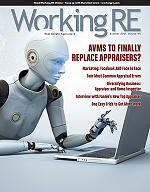 |
Services Offered this Issue
> The Appraiser Coach |
Editor’s Note: This story is from the latest print edition of Working RE. Don’t miss the next issue!
(Am I a Working RE Subscriber?)
Fannie Mae’s New Top Appraiser On the Future
by Isaac Peck, Editor
WRE: Hi Mr Dawson. Thanks for taking the time to speak with us. First a little professional background—are you an appraiser?
Dawson: Yes. I spent many years in the field as an appraiser and Realtor® before I took a position managing appraisal fulfillment and collateral underwriting at a large lender. Analyzing MLS data to truly understand local market dynamics was my favorite part of being an appraiser. As a Realtor, helping buyers, particularly first-time buyers, find a place to call home was always a rewarding experience. Most of my current team also spent time in the field as appraisers and in the primary market. So we continually challenge ourselves to keep those experiences and perspectives in mind during our work at Fannie Mae.
WRE: What would you like appraisers to know about Fannie Mae’s Collateral Underwriter (CU) and Appraiser Quality Monitoring (AQM)?
Dawson: Collateral Underwriter® and Appraiser Quality Monitoring are the result of over five years of capturing and carefully analyzing electronic appraisal data. Our objective with both is to drive improvement in appraisal quality and raise awareness across the industry about the importance of credible valuations. CU is a tool to help lenders manage appraisal quality more effectively and efficiently. It has been a great success with more than 1,800 lenders registered for CU access and over two million appraisals viewed by lenders in the CU web application.
The goal of AQM is to provide constructive feedback directly to appraisers. It has been extremely successful with more than 3,000 letters sent to appraisers and an improvement rate in excess of 90 percent. With such a high improvement rate, the list of appraisers subject to 100 percent post-acquisition review or whose appraisals are no longer accepted by Fannie Mae is relatively small. Adding appraisers to the published AQM list (appraisals not acceptable to Fannie Mae) is the last resort. We look forward to more engagement with our lender partners, appraisers and other industry stakeholders to improve appraisal quality and shape the future of the valuation process.
WRE: With respect to appraiser performance and review, we have heard that ensuring that appraisers make supportable adjustments has been a top focus of Fannie Mae since 2014. Would you say this is still true today? Do you have any practical tips or recommendations on the kind of support appraisers should be providing and where they can learn the techniques necessary to provide what Fannie Mae is looking for?
Dawson: Yes. Our work with AQM, CU and general outreach to the industry is starting to move things in the right direction but there is still an enormous amount of improvement needed when it comes to adjustments. The median GLA adjustment made by appraisers is generally the same regardless of property type, location, price tier, size, etc. We see appraisals in markets with properties selling for $600 or more per square foot, (SF) yet appraisers are still making the same $30/SF adjustment for GLA. They cite “paired sales analysis,” “conversations with local Realtors,” or “the appraiser’s experience” as support for the adjustments. This is a serious problem that needs to be addressed.
Appraisers can’t rely on old rules of thumb and have to start analyzing data from the markets they work in. Anyone actually doing the analysis would not come up with $30/SF. A little common sense also goes a long way. Can you upgrade from 1,000 SF to 1,500 SF in Washington, DC, for $15,000? Not a chance. Is the typical family shopping for a $500,000 home willing to downgrade from a two-bathroom property to a one-bathroom property to save $25 per month? No way. But that is what the appraiser is suggesting when they make a $5,000 adjustment for a second bathroom. We are simply looking for adjustments that reflect actual market reaction.
(story continues below)

(story continues)
WRE: What are the top problems you see? How can you help the industry improve and reduce or eliminate those problems?
Dawson: Data discrepancies and adjustments continue to be hot topics. There is great opportunity to leverage data, analytics and technology to improve data integrity and provide well-supported adjustments. We’ve seen existing and emerging technology providers developing new tools for appraisers which is exciting. However, it is important that appraisers truly understand the tools they are using and the results they produce. We’ve spent an enormous amount of time training our customers on how to use CU and that involves understanding the strengths and weaknesses of the application. It is no different with tools used by appraisers.
WRE: We’ve heard that based on Fannie Mae’s data, only 40,000 individual appraisers have submitted an appraisal that has gone through Fannie’s CU/UDCP portal. Can you confirm this? Have you seen this number decline in recent years?
Dawson: On average, we see about 40,000 unique appraisal credentials tied to UCDP® submissions each month and that number has been very steady for about three years. However, when we look at the numbers annually, that number is closer to 50,000. This is because some appraisers are not active for all 12 months. While the overall number of licensed appraisers has been declining, we have not seen a similar decline in active appraisers doing GSE business. Our analysis suggests that recent increases in costs and turn-times are more a function of unprecedented appraisal volume in 2016 than it is due to a sharp decline in the number of active appraisers. The underlying issue is that demand for appraisals is highly variable but the capacity is relatively fixed—as an individual appraiser and collectively as an industry. The result is unpredictable earning potential for appraisers and volatility in costs and turn-times for consumers of their services. Neither of which supports a healthy housing finance system.
(story continues below)
(story continues)
WRE: With respect to long-term goals, how do you see the appraisal form and process changing over time?
Dawson: We’ve made great progress with forms that were originally built for typewriter entry, but we are anxious to start thinking about new ways to capture data and report appraisal results. Personally, I’d like to see the forms be more dynamic than they are now. Less focus on free-form text entry and more focus on standardized data fields would enable further advancements with data capture and analysis. We also need to rethink what we’re capturing. There may be some information we currently ask for that is not material to the valuation but other useful data that is not captured in standardized format.
As for the appraisal process, advances in data and technology will make the process more efficient and increase the capacity of an individual appraiser. For years, lenders were at a significant disadvantage when it came to market data and analytical tools. Recently, that dynamic has changed. We’d like to see all parties to the transaction have access to better data, analytics, and technology. This will lead to more credible appraisals, better lending decisions, and more transparency in the process.
WRE: Where do you see the industry going in next five to 10 years? How do you think data and analytics will transform the industry? Do you see appraisers being a necessary part of the valuation process in the future?
Dawson: There is no doubt that data and analytics will continue to transform the industry. The only questions are how it will be transformed and how quickly. There is great opportunity to create a more independent, efficient and effective valuation process than we have today and we look forward to working with the industry to make that happen. Appraisers need to be part of that future valuation process although it may be different than it is today. Part of that transformation is to think about the highest and best use of an experienced appraiser. Is it pulling a tape measure and taking comp photos? Or is it analyzing local market data to pick the right comparables and make appropriate adjustments? Is it data gatherer or local housing market economist? In the future, I’d like to see the process evolve to a point where we can responsibly leverage technology to make the process more efficient and give appraisers the time and resources to focus on what matters most and truly requires their expertise.
> Just Published: OREP/WRE’s 2017 Fee Survey Results! To view the results in your state, click here. If you have not already taken the survey, please weigh in here.
> CE Online – 7 Hours (approved in 40 states)
How To Support and Prove Your Adjustments
Presented by: Richard Hagar, SRA
Must-know business practices for all appraisers working today. Ensure proper support for your adjustments. Making defensible adjustments is the first step in becoming a “Tier One” appraiser, who earns more, enjoys the best assignments and suffers fewer snags and callbacks. Up your game, avoid time-consuming callbacks and earn approved CE today!
Sign Up Now! $119 (7 Hrs)
OREP Insured’s Price: $99
About the Author: Isaac Peck is the Editor of Working RE magazine and the Director of Marketing at OREP.org, a leading provider of E&O insurance for real estate appraisers, inspectors and other real estate professionals in 50 states. He received his Master’s Degree in Accounting at San Diego State University. He can be contacted at Isaac@orep.org or (888) 347-5273.
Send your story submission/idea to the Editor: isaac@orep.org




by David Greenberg
CU is good as far as it goes but it falls way short of where it can be.
The specifics of how a specific score was derived must be transparent!
Many times when I have been able to see the model generated adjustments and comparable selection they contain some or mostly inappropriate information being scored. What the model calls comparable for instance at times can simply mean a similar size home within a certain proximity regardless of age, size, condition or date of sale.
CU is a tool that can be very good or very detrimental as with any tool where the user does not know what it takes to best use the tool and what it’s limitations are in a specific instance.
If a dwelling has been significantly improved or damaged since CU saw another appraisal report, it will point out that the current appraisal differs materially from something on file and presumably score adversely as to risk because it has NO apparent ability to account for legitimate changes in the property.
There needs to be a speedy ability to rectify an error in the rating. CU can not read the appraisal comments.
I would like to hear or see Mr. Dawson’s response to these specific concerns.
Thank you
-